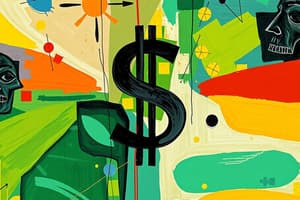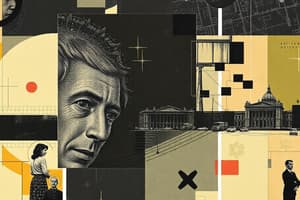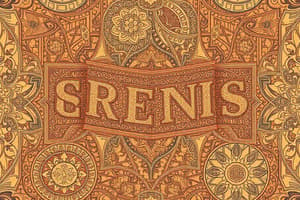Podcast
Questions and Answers
What is a primary characteristic of money according to the provided definition?
What is a primary characteristic of money according to the provided definition?
- It is always represented physically.
- It is a generally accepted medium of exchange. (correct)
- It has intrinsic value.
- It must be durable.
Why do coins sometimes carry value, according to the discussion?
Why do coins sometimes carry value, according to the discussion?
- They are issued by the government.
- Their value reflects the metal content. (correct)
- They can be used for bartering.
- They are collectible items.
What is indicated about modern coins in the discussion?
What is indicated about modern coins in the discussion?
- They can be exchanged for their metal content.
- They are backed by a commodity.
- They are tokens that represent a value. (correct)
- They typically have a fixed value based on metal prices.
What key concept is emphasized for the value of money?
What key concept is emphasized for the value of money?
What role does trust play in the value of money as discussed?
What role does trust play in the value of money as discussed?
How does Bitcoin differ from traditional forms of money in the discussion?
How does Bitcoin differ from traditional forms of money in the discussion?
What would happen to the value of a $10 bill if the consensus about its worth changes?
What would happen to the value of a $10 bill if the consensus about its worth changes?
What additional forms of money are mentioned besides coins and bank notes?
What additional forms of money are mentioned besides coins and bank notes?
What was the primary reason that Spain became one of the wealthiest countries in the world during the era of Potosi?
What was the primary reason that Spain became one of the wealthiest countries in the world during the era of Potosi?
How did the economy of Europe change as a result of the wealth from Potosi?
How did the economy of Europe change as a result of the wealth from Potosi?
What was the main consequence for the local people of Potosi in relation to the wealth generated from mineral extraction?
What was the main consequence for the local people of Potosi in relation to the wealth generated from mineral extraction?
What happened to Potosi as extraction of silver continued over time?
What happened to Potosi as extraction of silver continued over time?
What resource is now noted to be abundant in the Potosi area, following the depletion of silver?
What resource is now noted to be abundant in the Potosi area, following the depletion of silver?
What challenge is the Bolivian government currently facing regarding lithium extraction?
What challenge is the Bolivian government currently facing regarding lithium extraction?
Which countries were driven to search for their own sources of wealth as a result of Spain's riches from Potosi?
Which countries were driven to search for their own sources of wealth as a result of Spain's riches from Potosi?
What type of economy was primarily displaced by the influx of gold and silver from Potosi?
What type of economy was primarily displaced by the influx of gold and silver from Potosi?
What significant action did the New York banks take during the crisis in 1907?
What significant action did the New York banks take during the crisis in 1907?
Who was appointed to help resolve the banking crisis in 1907?
Who was appointed to help resolve the banking crisis in 1907?
What was one of the concerns raised by Congress regarding JP Morgan's involvement in the crisis resolution?
What was one of the concerns raised by Congress regarding JP Morgan's involvement in the crisis resolution?
Which year was the United States Federal Reserve created?
Which year was the United States Federal Reserve created?
What was one of the stated roles of the Federal Reserve upon its creation?
What was one of the stated roles of the Federal Reserve upon its creation?
What did the federal government provide to assist in resolving the 1907 banking crisis?
What did the federal government provide to assist in resolving the 1907 banking crisis?
What characterized Americans' view towards national institutions regarding money prior to the crisis?
What characterized Americans' view towards national institutions regarding money prior to the crisis?
What method did JP Morgan use to resolve the banking crisis?
What method did JP Morgan use to resolve the banking crisis?
What role has the Federal Reserve embraced in managing the economy?
What role has the Federal Reserve embraced in managing the economy?
Which event prompted Canada to eventually establish a central bank?
Which event prompted Canada to eventually establish a central bank?
What significant change occurred in Canada in 1931 regarding its monetary system?
What significant change occurred in Canada in 1931 regarding its monetary system?
What was the purpose of the royal commission established in Canada in 1933?
What was the purpose of the royal commission established in Canada in 1933?
What institution was created in Canada in 1935?
What institution was created in Canada in 1935?
How did political dynamics affect the Federal Reserve's operations?
How did political dynamics affect the Federal Reserve's operations?
What was the economic condition that led to the need for inflation management in Canada?
What was the economic condition that led to the need for inflation management in Canada?
What was a significant action taken by the Federal Reserve over the years?
What was a significant action taken by the Federal Reserve over the years?
What significant change occurred in 1938 regarding the Bank of Canada?
What significant change occurred in 1938 regarding the Bank of Canada?
Which of the following best describes the role of regular banks in a capitalist economy?
Which of the following best describes the role of regular banks in a capitalist economy?
What was a notable action by the Bank of Canada governor in the early 1960s?
What was a notable action by the Bank of Canada governor in the early 1960s?
What is the primary function of the Bank of Canada?
What is the primary function of the Bank of Canada?
How did banks contribute to the English industrial revolution?
How did banks contribute to the English industrial revolution?
What was the nature of the Bank of Canada after it was established as an arm's length institution?
What was the nature of the Bank of Canada after it was established as an arm's length institution?
Which statement reflects a misconception regarding banks' roles in capitalism?
Which statement reflects a misconception regarding banks' roles in capitalism?
In the context of bank operations, what does the term 'pooling money' refer to?
In the context of bank operations, what does the term 'pooling money' refer to?
What event in 1923 significantly impacted perceptions of the Canadian banking system?
What event in 1923 significantly impacted perceptions of the Canadian banking system?
How did the Canadian banking system respond to the challenges faced in the 1920s?
How did the Canadian banking system respond to the challenges faced in the 1920s?
What major banking change was introduced by the 1967 Bank Act in Canada?
What major banking change was introduced by the 1967 Bank Act in Canada?
Which of the following statements about the Great Depression is true regarding the Canadian banking system?
Which of the following statements about the Great Depression is true regarding the Canadian banking system?
What was one of the key outcomes of the findings of the Porter Commission in 1964?
What was one of the key outcomes of the findings of the Porter Commission in 1964?
Before the establishment of Canadian deposit insurance, what was a significant risk for depositors?
Before the establishment of Canadian deposit insurance, what was a significant risk for depositors?
What was one of the primary reasons for the Canadian banking system becoming more conservative during the 1920s?
What was one of the primary reasons for the Canadian banking system becoming more conservative during the 1920s?
What significant impact did the 1967 Bank Act have on Canadian consumers?
What significant impact did the 1967 Bank Act have on Canadian consumers?
Flashcards
Money's Definition
Money's Definition
Money is a generally accepted medium of exchange in a society enabling trade without barter, and is also a store of value.
Money as a Medium
Money as a Medium
Money facilitates transactions by acting as an intermediary for goods and services.
Money's Value
Money's Value
The value of money depends on the collective agreement and trust in its worth.
Coins as Tokens
Coins as Tokens
Signup and view all the flashcards
Paper Money's Value
Paper Money's Value
Signup and view all the flashcards
Digital Currency
Digital Currency
Signup and view all the flashcards
Bitcoin's Nature
Bitcoin's Nature
Signup and view all the flashcards
General agreement for monetary value
General agreement for monetary value
Signup and view all the flashcards
Potosi's Significance
Potosi's Significance
Signup and view all the flashcards
Spanish Colonial Exploitation
Spanish Colonial Exploitation
Signup and view all the flashcards
Shift to Cash Economy
Shift to Cash Economy
Signup and view all the flashcards
Lithium in Potosi
Lithium in Potosi
Signup and view all the flashcards
Importance of Lithium
Importance of Lithium
Signup and view all the flashcards
Bolivia's Lithium Strategy
Bolivia's Lithium Strategy
Signup and view all the flashcards
European Competition
European Competition
Signup and view all the flashcards
Potosi's Silver Depletion
Potosi's Silver Depletion
Signup and view all the flashcards
1907 Banking Crisis
1907 Banking Crisis
Signup and view all the flashcards
Government Response to 1907 Crisis
Government Response to 1907 Crisis
Signup and view all the flashcards
Role of JP Morgan
Role of JP Morgan
Signup and view all the flashcards
Federal Reserve System
Federal Reserve System
Signup and view all the flashcards
Federal Reserve's role
Federal Reserve's role
Signup and view all the flashcards
Maximizing Employment
Maximizing Employment
Signup and view all the flashcards
Economic Stabilization
Economic Stabilization
Signup and view all the flashcards
Banking Regulation
Banking Regulation
Signup and view all the flashcards
Federal Reserve's powers
Federal Reserve's powers
Signup and view all the flashcards
Political history of the Fed
Political history of the Fed
Signup and view all the flashcards
Bank of Canada's origin
Bank of Canada's origin
Signup and view all the flashcards
Need for Bank of Canada
Need for Bank of Canada
Signup and view all the flashcards
Great Depression's impact
Great Depression's impact
Signup and view all the flashcards
Gold standard impact
Gold standard impact
Signup and view all the flashcards
Fiat currency system
Fiat currency system
Signup and view all the flashcards
Bank of Canada's role
Bank of Canada's role
Signup and view all the flashcards
Arm's length institution
Arm's length institution
Signup and view all the flashcards
Central Banking Independence
Central Banking Independence
Signup and view all the flashcards
Commercial Bank's Function
Commercial Bank's Function
Signup and view all the flashcards
Capital Pooling
Capital Pooling
Signup and view all the flashcards
Historical Banking
Historical Banking
Signup and view all the flashcards
Banking System's importance
Banking System's importance
Signup and view all the flashcards
Government Influence on Central Banking
Government Influence on Central Banking
Signup and view all the flashcards
1923 Canadian Banking Crisis
1923 Canadian Banking Crisis
Signup and view all the flashcards
Impact of the Great Depression on Canada
Impact of the Great Depression on Canada
Signup and view all the flashcards
1964 Porter Commission
1964 Porter Commission
Signup and view all the flashcards
1967 Bank Act
1967 Bank Act
Signup and view all the flashcards
Mortgage Market Expansion for Banks
Mortgage Market Expansion for Banks
Signup and view all the flashcards
Canadian Deposit Insurance
Canadian Deposit Insurance
Signup and view all the flashcards
The Impact of the Banking Crisis of 1923 on Future Canadian Banking Regulation?
The Impact of the Banking Crisis of 1923 on Future Canadian Banking Regulation?
Signup and view all the flashcards
How Did the 1967 Bank Act Modernize the Canadian Banking System?
How Did the 1967 Bank Act Modernize the Canadian Banking System?
Signup and view all the flashcards
Study Notes
Money and Finance
- Money is defined as a generally accepted medium of exchange enabling trade without barter; it's also a store of value.
- Money includes coins, banknotes, and electronic records representing value.
- The value of money depends on the agreement of the people that it represents value.
- Historically, some coins were valued for metal content.
- Modern coins are tokens representing value, not solely the metal's worth.
- Paper money represents an agreed-upon value.
- Digital currency uses digital records, rather than physical form.
- Examples of different types of money
- Commodity money (gold, silver, shells)
- Token money (coins, paper)
- Fiat money (backed by government decree)
- Fiat money, issued by a government, is not backed by a commodity. Its value is based on the government's authority and the public's confidence.
- The gold standard was an example of a system where currency was backed by a specific quantity of gold.
- The concept of "a run on a bank" was discussed—a situation where many customers simultaneously demand their money from a bank.
- The Bank of England, a central bank, was created to manage the public debt and issue British currency based on the gold standard.
- The Federal Reserve, established in 1913, is the central bank of the United States. Its creation addressed financial crises (like the 1907 crisis).
- The central bank of Canada's purpose is to manage the nation's money supply.
- The creation of central banks like the Federal Reserve and the Bank of Canada sought to stabilize and regulate financial systems and mitigate the risk of financial crisis.
- Central Banks can maintain employment, stabilize prices, and control interest rates.
- Central banks use instruments like monetary policy to manage interest rates and money supply.
- Central banks (like the Fed and Bank of Canada) originally had private influence, eventually becoming independent and government operated institutions.
Potosi and Silver
- Potosi, a city in South America, witnessed an enormous silver mine, a significant factor in the rise of Spanish wealth.
- The indigenous population was forced to mine silver under harsh conditions.
- The wealth from Potosi helped Spain to exert significant economic and military influence globally.
- The Potosi silver mine was instrumental in the economic shift towards a cash-based economy.
- Potosi's mineral wealth influenced global power dynamics and trade.
Modern Banking
- Banks facilitate the flow of money by issuing loans to businesses and individuals.
- Banks bundle individuals' deposits to provide loans and credit to others.
- Banks play a crucial role in economic activity by facilitating transactions.
- Banking systems have evolved to incorporate modern technologies; examples, digital payments.
- Deposit insurance protects depositors up to a certain amount, insuring that deposits are safe in case of bank failure.
Studying That Suits You
Use AI to generate personalized quizzes and flashcards to suit your learning preferences.




